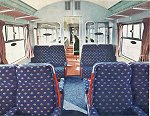Class 101 Met-Camm 2,3 & 4-car DMUs
Interiors
The interiors of the passenger saloons remained pretty standard throughout the builds with only minor changes. All walls and partitions were formica covered, with painted hardboard ceilings. Floors were lino covered and carpeted in first class. Luggage racks were at first alloy frames with string racks until an all alloy rack was introduced part way through production. Tungsten lighting used the standard silver ringed lamp shades.
Through the years there were a variety of formica colours used, as shown in the table below.
| Orders | 1st class | 2nd class | Vestibule |
|---|---|---|---|
| 2a - 2f | Light green | Light green | Light green |
| 2g - 2k | Light blue | Light green | Light green |
| 2l | Cream /buff | Cream /buff | Cream /buff |
| 2xa | Light blue | Light green | Light green |
| 3 | Light blue | Light green | Light green |
| 4 & 5 | Grey / off-white | Cream /buff | Cream /buff |

The first image is from a Met-Camm publicity brochure - a rare colour interior photo, although probably a B&W pic that has been 'colourised'. It shows one of the earlier cars - as it has string luggage racks - which are stained maroon. The alloy beading (such as around the windows) had the centre section painted maroon.
The TBS(L) vehicles had a small corner caged area and a handbrake wheel in the van (power cars had a handbrake in the cab, with no handbrake in the guards van on a DMBS).

The next image, taken on a Birmingham area unit on the 19th April 1969, shows the second class saloon in a composite vehicle. The seats have been re-covered since new, using 'Trojan' moquette. This image also shows the solid alloy luggage racks. Stuart Mackay Collection.
2+2 Seating

2+3 seating was normal in second class but a few batches for the North Eastern Region (2a, part of 2g, 2h) had 2+2 seating. This can be seen seen in the final batch in a power car from batch 2a.
Summary
Orders
Batches
Description - Technical
Description - Interior
Description - Variations
Description - Modifications
Met-Camm Adverts
Diagrams
Drivers Instructions
Refurbishment
Numbering
Liveries
Operations - Initial
Operations - Later
Operations - Scottish Region
Accidents
Daisy - 101685
Observation Saloon 6300
Parcel Use
Departmental Use
Images
Details about preserved Class 101s can be found here.
Many thanks to Mac Winfield and Eddie Knorn for their assistance in the preparation of this section.


